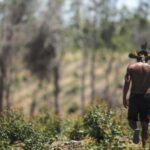How reputational risk can compromise sustainable forest management
You won’t often hear me suggest that ESG should be downgraded in priority in a forest management, business, or investment decision, but a recent experience has caused me to question myself.
This is an article about reputational risk, the umbrella of ESG, sustainable forest management (SFM), and business. It looks at two strongly held beliefs by the environmental community in the E of ESG and describes the risk to the forest itself if we put reputational ESG considerations ahead of SFM principles.

Unpacking Reputational Risk in the context of Forest Investment
Reputational risk relates to the potential harm to an investor/investment manager or company’s image, brand, or standing in the eyes of its stakeholders. This includes its shareholders or investment partners, customers, employees, regulators, local communities, and NGOs.
In the context of ESG and forest investment, reputational risk is linked to the public perception that the organization in question is negatively impacting environmental, social or governance issues related to the forest under its control.
On the environmental side – it would relate to a company’s perceived malpractice regarding sustainable forest management. This could include public perception that the wrong tree species are used (for example use of exotics), clearcutting on steep slopes where it creates erosion and landslides, polluting waterways with pesticides and fertilizers and so on.
On the social side – it could refer to stakeholder impacts of forest operations, where the public are vocal that indigenous stakeholders have not been engaged in free, prior, and informed consent, or that equitable work opportunities are not part of human resources policies and procedures.
With respect to governance – the public may bring to attention a company that is not transparent with its corporate governance, or bring attention to a company or investor’s involvement in corruption and bribery or human rights breaches.
When the E in ESG opinion is wrong for Sustainable Forest Management
An important distinction with reputational risk compared to other ESG and business risks is that it may be illogical and based solely on perception or emotion and the ‘hot topic’ de jour.
Let me describe this by way of example.
Company X operates in alignment with scientifically sound, sustainable forest management principles. But, like most forest companies, it has the uphill public-image battle, where its business is reliant on cutting down trees. Unfortunately, the general public has not been educated on the importance of sustainable forest management for meeting several environmental, social and economic objectives.
Company X operates under several different forest management regimes – ranging from sustainably managed semi-natural and natural forests to single-species plantations. It operates in accordance with the applicable forest management regulations, goes a step further in achieving voluntary forest management certification, and goes even further to identify and execute programs where it can have significant co-benefits to local communities and the environment.
Company X has both shareholders and customers that are far removed from the forest, sometimes countries or continents away, making critical decisions from their so-called ivory towers. Unfortunately, as in the example I am referring to, the decisions on the table are not scientifically, but emotionally based. And the alternatives on the table can go against sustainable forest management principles.
I believe that the two most heavily emotional value statements in forest management stem from the following beliefs:
- Monoculture forest plantations are bad
- Harvesting native forests is bad
The following sections break down each of these, explaining what I see as two main risks to sustainable forest management: indirect land-use change, or leakage and increased wildfire severity.
Please bear in mind before you get your feathers ruffled – I am not for or against monoculture plantations and native forest harvesting in every situation. This is a highly nuanced and context-specific debate. The following descriptions present the extreme ends of the spectrum.
Public Perception: Monocultures forest plantations are bad
Ivory Tower Decision: Ban single-species or exotic tree use, divest from single-species and exotic plantations, convert to mixed-species or native species forests
The SFM risk of this decision: Monoculture and exotic species plantations have a bad name. And to the former, – there isn’t even a commonly agreed definition of what monoculture in the context of a forest plantation is. In this article, I describe the controversy around monoculture.
The risk to SFM if we are to stop the use of monoculture plantations and using exotic tree species is primarily indirect land-use change, or ILUC – a term popularized in the biofuels sector (EU, 2012). In plantation forestry areas where the use of exotics are common, these practices often exist because harvesting native forests at the scale needed to meet demand is not sustainable. If plantation fiber is no longer available, it could spur harvesting in these native forests, which are more valuable for their rarity, biodiversity, and ecosystem services. This is more of a risk in emerging markets where there is little enforcement of forest governance, and the management of natural forests is weak.
Where forest legislation prevents or strictly regulates harvesting native forests, like in New Zealand for example, banning the use of plantations/exotics would translate to a wood shortage. As the population both increases and looks to decarbonize, the demand for various wood products is increasing. ILUC could still exist in this scenario, where in the NZ example, importers of NZ wood will source fiber elsewhere – that will likely come from exotic plantations in any case.
Though not an impact on sustainable forest management per se, and more about balancing objectives – Converting to mixed (native) species over time, is the best alternative compared to a ban, but there are considerations to be made. For mixed species – you need to understand the interaction between the chosen species in the ecosystem where they are planted and the silvicultural complexities (do they require different management regimes – such as thinning, pruning, and harvesting). For converting to native species from exotics, though it would absolutely be better for restoring a forest to a natural ecosystem, it would jeopardize sustainable wood supply objectives. Exotic species are used because their characteristics are well understood – both for wood quality and impact on the environment. They are often chosen because they grow quickly. In many regions, the science and best practice for growing native species for commercial use is not well understood, and if there are management objectives to produce sustainably managed wood products – this objective could be compromised.
Public Perception: Harvesting from natural forests is bad
Ivory Tower Decision: Ban harvest of natural forests, divest from regions where it is a standard practice. Only invest in plantation forestry (hmmm, but doesn’t this go against the previous principle? Head scratcher…)
The SFM risk of this decision: Increased severity and extent of wildfire. I’m sure this is a controversial statement, but let’s consider what would happen on the severe end of the spectrum, where there is no harvesting of native forests. Amidst the warming climate we are now living in, what we can expect to ensue is more pests and disease in the forests and more frequent acute weather events (lightning storms). With a ban on harvesting, we could expect an increase in biomass in these climate-stressed forests. Wildfire severity and extent would increase thanks to a greater fuel-load, feeding wildfires that don’t have the resilience to withstand the fires. In his paper, titled: Mega-fires, tipping points and ecosystem services: Managing forests and woodlands in an uncertain future, Mark Adams describes this predicament. Though the paper is more than 10-years old, recent experience in increasing mega-fires indicates that his findings remain current.
Appropriate sustainable forest management that includes harvesting and other silvicultural practices, such as thinning and even controlled-burning (practiced by indigenous people for millennia), also demonstrated in this study, is critical for maintaining healthy forests and limiting emissions from severe wildfires.
If the proponent of the no-harvest in natural forests value statement is also against plantation forestry, we are in for a real challenge. What is the alternative to this renewable resource?
Foresters thinking like Doctors
I like to use the analogy of the medical profession, and the Physician’s Hippocratic oath, specifically, first – do no harm. Imagine a situation where a critically injured person comes into the hospital with a life-threatening injury and the injured person’s family and friends demand a certain treatment, where the Doctor knows, from his/her expertise that another treatment would save the patient’s life, and the one proposed by the friends and family may cause further harm.
As foresters, we have a similar responsibility to the forests. You could liken the media, ivory tower shareholders and customers to the family of the injured person – they mean well, but their solutions are not fact-based. Should we let those whose experience with forests is emotional make forest management decisions, or the foresters who know the ins and outs, direct and indirect forest management impacts?
Appropriate ESG and Impact Considerations for Forest Investment
As both a forester and an ESG practitioner in forest investment – I have a keen eye for these conundrums. If you are developing and/or implementing a forest investment strategy where you want to ensure that ESG and reputational risks are considered alongside strong SFM principles, all while ensuring commercial viability, reach out – and we can construct the appropriate solution for your strategy.
Did you like this article? Sign up now for the ForestLink’s newsletter, where you’ll receive technical advice, reflections, and best-practice guidance to support you with your forest-linked investment strategy or business straight to your inbox.





